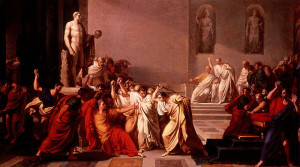It’s most likely that the calendar you’re using today reads something similar to 13/11/2015, has 12 months, 365 days in the year and an extra day every leap year. The Gregorian calendar is the most commonly used civil calendar in the world today. It’s a pretty easy way to understand what time of year it is and when seasons occur, because it’s so regular. But it wasn’t always like this. The Gregorian calendar itself is a revision of an earlier calendar with a similar regularity to it, the Julian calendar (there is only a difference in length between the two of 0.0002% difference between the two, or 10 minutes and 48 seconds each year).
The Julian calendar was created in 46 BCE out of the chaotic calendar of Numa. Over the two centuries leading up to 46 BCE the Numan calendar had come seriously out of alignment, and was roughly 80 days out. Times of crisis, wars, and political squabbling had meant that people had either forgotten to add, or intentionally left out, the intercalary month and religious holidays. The intercalary month was a month inserted between February and March every few years, to bring the 355 day calendar in line with the cycle of seasons. The month and religious days had to be declared by the chief priests of the ancient Roman religion, the Pontifex Maximus. However the Pontifex Maximus had become a politicised position over the centuries meaning that, as mentioned above, the Pontifex Maximus was able to abuse their power over the calendar to leave days out and shorten the period of office for their political opponents. The situation became so bad that Julius Caesar, in 46 BCE, used his power as Pontifex Maximus to completely reform the calendar. He made the year 365 days long, adding an extra day every 4th (leap) year, and created created the months we use today. In order to begin the next year, 45 BCE, in the correct season he added two extra months along with the intercalary month, meaning that 46 BCE had a grand total of 15 months and was 445 days long. Caesar called it ‘the last year of confusion’, but other people just referred to it as ‘the year of confusion’ or ‘annus confusionis’ in Latin.
So, just be thankful that Caesar gave us a calendar that made sense, and that we don’t have to go through a year of confusion like that.







